Friday, June 30, 2006
Tourist Break June 27


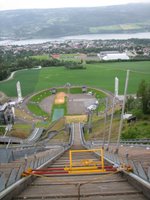 So, I have to be a tourist sometimes and not just a woodworking researcher. Once the museum had closed, I trekked up the hill to get a look at the Lillehammer Olympic ski jump. You might know that I am an avid skiier, but you probably do not know about my pre-teen delusions about my future as an Olympic skiier. Bill Johnson's gold medal in the early 80's probably inspired this optomistic plan. He was a teenage delinquent stealing cars for fun. He had never skiied until he was put into some sort of ski rehab at 19 years old, then he won the gold. Well, I had a much earlier start (at skiing . . . late starter for auto theft), and I was still years from being 19, so there you have it.
So, I have to be a tourist sometimes and not just a woodworking researcher. Once the museum had closed, I trekked up the hill to get a look at the Lillehammer Olympic ski jump. You might know that I am an avid skiier, but you probably do not know about my pre-teen delusions about my future as an Olympic skiier. Bill Johnson's gold medal in the early 80's probably inspired this optomistic plan. He was a teenage delinquent stealing cars for fun. He had never skiied until he was put into some sort of ski rehab at 19 years old, then he won the gold. Well, I had a much earlier start (at skiing . . . late starter for auto theft), and I was still years from being 19, so there you have it.The amount of huffing and puffing it took to get me up to the base of the Olympic stadium is probably some indication that I am not in Olympic condition, but it did take some determination to climb through town in the rain. Hungry. At night! (Well, it doesn't get dark, but still it was evening and I could have been sitting on a sofa having a beer.) I rode the chairlift up to the top of the ski jump tower and got to stand right at the competitors launching pad. Pretty steep for not being allowed to turn on your way down. I tried to imagine what might be going through one's head at this moment. "OK, am I ready for the next 3 seconds? . . . . I should be since I've been getting ready for the next 3 seconds for my entire life . . . just don't dig that edge in and break your neck like that other fellow . . . concentrate, focus, ok, give me a minute to breathe first . . . . ". Probably they aren't thinking anything. These are professionals! If there was any shred of Olympic downhill dreams left in my mind, the downhill simulator fixed that. I thought it would be exhillerating, but the virtual experience of going 130 km/hour around the gates was nauseating. I was so relieved that I made it to the bottom. As I was catching my breath, the screen showed the top of the bobsled course. That was when I hit the "Emergency Stop" button.
On June 28, I took the East-West Express bus across Norway from Lillehammer to Bergen. This is beautiful country. I feel like I am driving through a postcard, a really green and curvy postcard. Now I wonder why I brought everything except for Dramamine to Norway.
Lillehammer, June 25-27


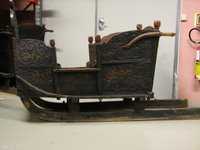



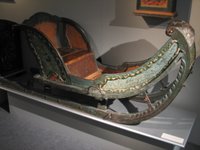

 Lillehammer was fantastic (no time for posting updates though). On the train to Lillehammer, the person sitting next to me was a deaf girl in high school or maybe college. It was wonderful practice for me to talk to her because I got to write in Norwegian, and she would write back in English. This is much easier than actually speaking and listening. She hates George Bush, by the way.
Lillehammer was fantastic (no time for posting updates though). On the train to Lillehammer, the person sitting next to me was a deaf girl in high school or maybe college. It was wonderful practice for me to talk to her because I got to write in Norwegian, and she would write back in English. This is much easier than actually speaking and listening. She hates George Bush, by the way.At Lillehammer, I was welcomed into Maihaugan, a museum complex consisting of a large open air museum of dozens of old buildings collected from this region of Norway and set into a village, as well as an actual musem with a large collection of Norwegian objects. The curator, Kåre Hosar, left me the keys to the museum's guest house, so I had my own apartment for a few days.
The collection is huge, but most of it is behind locked doors. Lucky for me, Kåre Hosar was able to spend the better part of the day with me, escorting me through the storage, allowing me to pull out all of the objects I wanted to see and photograph. He also is an expert on the collection, and quickly educated me on many aspects of Norwegian material culture. I was most interested in seeing the sleds, and then in any other wood objects particular to Norway. I got what I came for. There are dozens of sleds in storage there.
The sleds here are Norwegian. They are not Sami or Viking like the other sleds I saw in Oslo. The earilest sleds at this museum are from the 1600's. These are really box-like in form, and are not so different in construction from a Norwegian blanket chest with either tennons or nails at the corners. These are considered Renaissance sleds. The carving on them begins to show stylized botanical motifs with a very simple acanthus leaf. The acanthus leaf is Mediterranian, the one used to decorate the tops of Corinthian columns in ancient Greece. The acanthus motif continued to be an influence from ancient times through the Middle Ages, and through the Renaissance. The motif experienced a Baroque revival in Norwegian folk art in the 1700's, as one can see in these sleds. The acanthus leaf motif really flourished in Norwegian folk art after it appeared in the alter at the main church in Oslo in 1699, and then in the pulpit at Lillehammer in 1705. At this point, the sleds had very little metal in them, indicating that metal parts were still relatively unavailible and expensive.
In the mid to late 1700's, the decoration of the sleds blends several influences. The style of the carving- the twisting, elaborate botanical imagery in geometric layouts- is similar to the French Rococo style, but whereas the French would have shells and rocks as the imagery, the Norwegians were incorporating the classical acanthus leaf. The influence of the French becomes very apparent in the form of the sleds as they change to bulbous, curvilinear forms by the 1800's. This is the Empire style of the early 1800's. The panels of the sled sides are carved from thick, solid wood panels reminiscent of the "bombe" chests and cabinets from this era of French furnituremaking.
There were some other very interesting wood objects to see here, including a huge number of hand tools, especially planes. I am sure the College of the Redwoods crowd would have been thrilled to see these tools. Check out the enormous jointer plane I am holding!There were also numerous flat objects with handles that were intricately carved and painted. These are called "mangletre", and are used in conjunction with a rolling pin type rod for flattening clothes, some labor intensive way of ironing without heat. These objects are collectable because of how common they were to Norwegian households, and also because they were so decorative. Men would make these mangletre to prove their craft skills and to impress the women. A mangletre was the traditional engagement gift. I don't think a marraige proposal accompanied by the gift of an iron would go over so well anymore. . . a lot of guys would get big bumps on their heads for that one!Another odd object was a stick like a ruler with notches and pictographs down the edges. These are called "primstav" and are a type of almanac with every day of the year as a tic or notch, and then specific symbols to correspond with particular important days of the year. All primstav had the same symbols and days marked, so the marks were for important days on the Norwegian calendar, not personally important days like your Mom's birthday. If I make one, I will put everyone's bithday on it.
Saturday, June 24, 2006
Still in Oslo
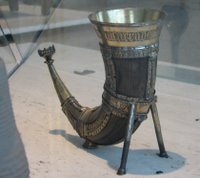




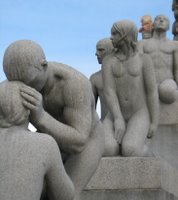

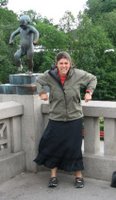

 Today started about three days ago. I'm still waiting for the sun to go down! Last night was the official "Midnight Sun" celebration around town, so we wandered the streets until after midnight just so I could see the sun not go down for myself. They make really good ice cream here, by the way. I would recommend the double scoop of strawberry and vanilla. J-P recommends pistacio but would not order the mango again.
Today started about three days ago. I'm still waiting for the sun to go down! Last night was the official "Midnight Sun" celebration around town, so we wandered the streets until after midnight just so I could see the sun not go down for myself. They make really good ice cream here, by the way. I would recommend the double scoop of strawberry and vanilla. J-P recommends pistacio but would not order the mango again.We started at the Kulturhistorisk Museum to see Viking and Sami objects. The horn drinking cups keep making me laugh every time I look at them. They are like circus seals propped up on their little legs. I am switching to these when I get home. The carved doorways are amazing too, and the museum had several of these in good condition.
We then proceeded to the Kunstindustrimusett where we saw many amazing objects from more recent history up to present. No photography was permitted, but I managed to sketch a few things. I was already whelmed when I got there, so I became over-whelmed by the extensive collection. Some of the modern work was really clever and inspiring, like the bent laminated stool with a compound curve. There was a great room full of art nouveau cabinets too complex to draw, and several rooms with mid-century modern beginning with Hans Wegner. There was so much good stuff, we had to leave and find some coffee and chocolate to recover.
We had to circumnavigate the Gay Pride parade that had blocked the main street through Oslo, but did eventually manage to get to Vigelandsparken, the huge park for which Gustav Vigeland made hundreds of figurative sculptures in granite and bronze. It is evident through the pictures that most people enjoy the work. I had to throw a tantrum though. I think J-P is going to throw a tantrum if I do not quit the computer soon.
Friday, June 23, 2006
Oslo again
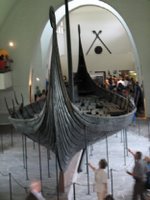



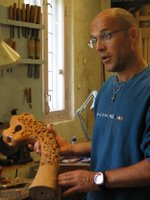


This morning when I woke up I was still in Oslo, and so was the famous and rarely seen J-P Vilkman, direct from Finnland. We went to the Vikingshiphuset (Viking Ship Museum) to see the famous Oseberg ship, as well as the sleds and objects that were discovered on board this ship from a royal Viking burial mound dated around 850. We met with the conservator, Nadine Huth, and the museum´s wood carver, Bjarte Aarseth. Currently, they are working to support and restore the sleds because they are extremely brittle from the chemicals used in the 1908 conservation efforts. Bjarte showed us the reproductions he is working on in his shop. Museums around the world borrow the reproductions. These reproductions gave us a unique oppertunity to see the carved patterns up-close. The sleds are from the 9th century AD or earlier, but show the incredibly advanced handwork of the Vikings. Of course, these particular sleds were used to carry a queen and are subsequently extremely fancy with all of the figures in the patterns being symbols to ward off evil spirits and bring luck. It is interesting to compare these to the rough-hewn, quickly made, utilitarian pulk sleds of the Sami which are from around 1850, one thousand years later.
After getting a $4 cup of coffee and a $25 piece of quiche for J-P (just normal here, which is why I luckily had my handy pocket knife and picnic items on hand), we proceeded to the Kon Tiki Museum to see the Kon Tiki and the Ra II. This has nothing to do with actual Nordic woodcraft, but these are nonetheless perhaps the most famous boats in Norway from Thor Heyerdahl´s famous trans-oceanic expeditions. The Viking spirit carries on! By the way, I am half Viking myself, plus Scottish, German, and Basque to round it out.
Oslo

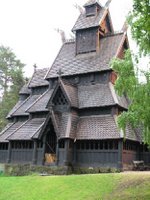

 After arriving in rainy Oslo on Thursday (Torsdag) morning, I went to the Norsk Folkemuseum to see examples of Sami/Lapp objects, Norwegian wood objects, and building constructions, including stave churches. I spent most of the time learning to work my camera. Not really.
After arriving in rainy Oslo on Thursday (Torsdag) morning, I went to the Norsk Folkemuseum to see examples of Sami/Lapp objects, Norwegian wood objects, and building constructions, including stave churches. I spent most of the time learning to work my camera. Not really.The amazing part of my visit was when the curator, Leif Pareli, took me to see the storage areas for the Sami (Lapplander) sleds called pulks. These are the sleds pulled by reindeer, the making of which is nearly a lost art due to the introduction of the snowmobile in the 1960's. I will be visiting some of the only known pulkmakers in North-North-Norway during this trip. They live in Santa's neighborhood. The bummer is that in uploading these photos, I somehow deleted the pictures off my camera. Enjoy them here!